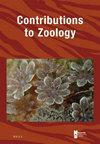Dating the origin and diversification of Pan-Chelidae (Testudines, Pleurodira) under multiple molecular clock approaches
IF 2.1
2区 生物学
Q1 ZOOLOGY
引用次数: 12
Abstract
Pan-Chelidae (Testudines, Pleurodira) is a group of side-necked turtles with a currently disjointed distribution in South America and Australasia and characterized by two morphotypes: the long-necked and the short-necked chelids. Both geographic groups include both morphotypes, but different phylogenetic signals are obtained from morphological and molecular data, suggesting the monophyly of the long-necked chelids or the independent evolution of this trait in both groups. In this paper, we addressed this conflict by compiling and editing available molecular and morphological data for Pan-Chelidae, and performing phylogenetic and dating analyses over the individual and the combined datasets. Our total-evidence phylogenetic analysis recovered the clade Chelidae as monophyletic and as sister group of a clade of South American extinct chelids; furthermore Chelidae retained inside the classical molecular structure with the addition of extinct taxa in both the Australasian and the South American clades. Our dating results suggest a Middle Jurassic origin for the total clade Pan-Chelidae, an Early Cretaceous origin for Chelidae, a Late Cretaceous basal diversification of both geographic clades with the emergence of long-necked lineages, and an Eocene diversification at genera level, with the emergence of some species before the final breakup of Southern Gondwana and the remaining species after this event.多分子钟方法测定盘螯蟹科(Testudines,Pleurodira)的起源和多样性
盘螯龟科(Testudines,Pleurodira)是一组侧颈龟,目前在南美洲和澳大拉西亚的分布不连贯,有两种形态类型:长颈龟和短颈龟。这两个地理群都包括两种形态类型,但从形态学和分子数据中获得了不同的系统发育信号,这表明长颈螯类的单系性或这一特征在两个群中的独立进化。在这篇论文中,我们通过汇编和编辑Pan Chelidae的可用分子和形态学数据,并对个体和组合数据集进行系统发育和年代测定分析,来解决这一冲突。我们的全证据系统发育分析表明,Chelidae分支是单系的,是南美洲已灭绝螯类分支的姐妹群;此外,Chelidae保留在经典分子结构中,在澳大拉西亚和南美分支中都增加了已灭绝的分类群。我们的测年结果表明,总支Pan Chelide起源于侏罗纪中期,Chelide的起源于白垩纪早期,两个地理支的晚白垩世基底多样化,出现了长颈谱系,以及属级的始新世多样化,在南冈瓦纳大陆最终解体之前出现了一些物种,而在这一事件之后出现了其余物种。
本文章由计算机程序翻译,如有差异,请以英文原文为准。
求助全文
约1分钟内获得全文
求助全文
来源期刊

Contributions to Zoology
生物-动物学
CiteScore
4.00
自引率
4.50%
发文量
16
审稿时长
>12 weeks
期刊介绍:
Contributions to Zoology solicits high-quality papers in all systematics-related branches of comparative zoology (including paleozoology). Preference will be given to manuscripts dealing with conceptual issues and to integrative papers (e.g., ecology and biodiversity, morphology and phylogeny and character state evolution, phylogeny and historical biogeography, systematics and bioinformatics, bioinformatics and biodiversity, habitat disturbance and biogeography, etc.). Reviews and alpha-taxonomic contributions are considered for publication, but acceptance will depend on their high quality and exceptional nature.
 求助内容:
求助内容: 应助结果提醒方式:
应助结果提醒方式:


